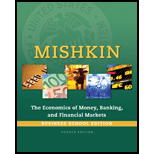
In case the question requires us to explain influence of hyper inflation on
Concept Introduction:
Portfolio theory: American economist James Tobin justified that rational individuals will keep portfolio of consisting of money (cash) and bond rather than keeping wealth either in money (cash) or bond. According to Tobin, people are in general risk averse. Human behaviour demonstrates risk aversion. This implies that, they have a preference towards lesser risk at a given
Want to see the full answer?
Check out a sample textbook solution
Chapter 22 Solutions
Economics of Money, Banking and Financial Markets, The, Business School Edition (4th Edition) (The Pearson Series in Economics)
- Typically, spending in an economy is divided into four components. What are they? Which is the largest component? Which is the most steady from one period to another? Which is most volatile from one period to another? Explain why for your two previous answers.arrow_forwardMichelle Wie, a teenage golf prodigy, earned $16 million from endorsements and $4 million in prize money in 2006. In 2007, she announced that she would enroll in Stanford University for the Fall term. What was her opportunity cost for the 2007-2008 academic year? How does it compare to your opportunity cost of a year at University?arrow_forwardWhy do we add up total spending to compute GDP when GDP is supposed to be measuring production?arrow_forward
- not use ai pleasearrow_forwardGDP 2017 Q3 2.8% Equipment 9.8% Nonresidential Structures 5.7% 2017 Q4 2.3 9.9 1.3% 2018 Q1 2.2 8.5 13.9 2018 Q2 4.2 4.6 14.5 2018 Q3 3.4 3.4 -3.4 2018 Q4 2.2 6.6 -3.9 (Note: all figures on an annual rate basis) The quarterly growth rates of real GDP and investment spending on equipment and structures for the six quarters prior to the pandemic are described above. In his first term in office, Trump lowered both personal and corporate income tax rates, expecting these moves to generate stronger growth. These took effect in January 2018 although the taxes withheld from paychecks did not drop immediately. Based on the data above, did the tax cuts do what they were expected to do? Be specific.arrow_forwardEconomists prefer to analyze the performance of the economy using “real” rather than nominal measures of economic activity. First, what does it mean to use real variables using consumption and wages as cases in point? Warning: before you throw at me the catch-all “adjusted for inflation” answer, know that I am looking for a thoughtful answer that explains in everyday English the difference between real and nominal and why it matters in the context of wages and interest rates.arrow_forward
- not use ai pleseaarrow_forward3 Producer Surplus, PS $12 $11 S Book Print rences Legend ●Demand ● Supply Price $10 $9 $8 $7 $6 D $5 0 1 2 3 4 5 6 7 8 00 Tons of Wheat (in thousands) 9 10 a. Indicate the consumer surplus if the market is in equilibrium. Instructions: Use the tool provided "Consumer Surplus, CS" to shade in the consumer surplus area on the graph. b. Indicate the producer surplus if the market is in equilibrium. Instructions: Use the tool provided "Producer Surplus, PS" to shade in the producer surplus area on the graph.arrow_forwardFigure 4-4 PRICE a P B Q a QUANTITY Supply Refer to Figure 4-4. The movement from point A to point B on the graph is called a decrease in supply. an increase in supply. an increase in the quantity supplied. a decrease in the quantity supplied. tv all A 18arrow_forward

 Principles of Economics (12th Edition)EconomicsISBN:9780134078779Author:Karl E. Case, Ray C. Fair, Sharon E. OsterPublisher:PEARSON
Principles of Economics (12th Edition)EconomicsISBN:9780134078779Author:Karl E. Case, Ray C. Fair, Sharon E. OsterPublisher:PEARSON Engineering Economy (17th Edition)EconomicsISBN:9780134870069Author:William G. Sullivan, Elin M. Wicks, C. Patrick KoellingPublisher:PEARSON
Engineering Economy (17th Edition)EconomicsISBN:9780134870069Author:William G. Sullivan, Elin M. Wicks, C. Patrick KoellingPublisher:PEARSON Principles of Economics (MindTap Course List)EconomicsISBN:9781305585126Author:N. Gregory MankiwPublisher:Cengage Learning
Principles of Economics (MindTap Course List)EconomicsISBN:9781305585126Author:N. Gregory MankiwPublisher:Cengage Learning Managerial Economics: A Problem Solving ApproachEconomicsISBN:9781337106665Author:Luke M. Froeb, Brian T. McCann, Michael R. Ward, Mike ShorPublisher:Cengage Learning
Managerial Economics: A Problem Solving ApproachEconomicsISBN:9781337106665Author:Luke M. Froeb, Brian T. McCann, Michael R. Ward, Mike ShorPublisher:Cengage Learning Managerial Economics & Business Strategy (Mcgraw-...EconomicsISBN:9781259290619Author:Michael Baye, Jeff PrincePublisher:McGraw-Hill Education
Managerial Economics & Business Strategy (Mcgraw-...EconomicsISBN:9781259290619Author:Michael Baye, Jeff PrincePublisher:McGraw-Hill Education





